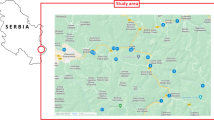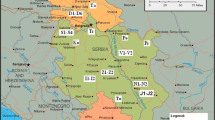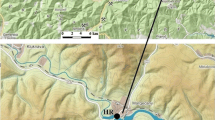Abstract
The behavior of metals in sediments after their disposal to land has important implications for the environmental management. The sediment from the Carska Bara (Serbia) was polluted with adequate metal salts in order to reach severe contamination based on the pseudo-total metal content of Pb, Cd, Ni, Zn, Cu, and Cr according to the corresponding Dutch standards and Canadian guidelines. The toxicity and fate of the metal in sediment depend on its chemical form, and therefore, quantification of the different forms of a metal is more meaningful than the estimation of its total concentration. In this study, fractionation of metals in sediment has been investigated to determine its speciation and ecotoxic potential, as well as evaluation of metal potential toxicity based on the simultaneously extracted metals (SEMs) and acid volatile sulfides (AVSs) analysis at the beginning of the experiment and after 5 weeks of sediment aging. The investigations suggest that Cd, Pb, and Zn have a tendency to associate with labile fraction, the most mobile and most dangerous fraction for the environment. Risk assessment code revealed their high risk. Copper and chromium showed low to medium risk to the aquatic environment. Nickel showed no risk to the aquatic environment. This was the case at the beginning and after 5 weeks of aging. Aging yielded an increased mobility of all metals based on the increased proportion in mobile fractions. The Σ[SEM i ]/[AVS] ratio was found to be >1 both at the beginning and after 5 weeks of aging, with the ratio showing an increase with time. This ratio indicates the potential availability/toxicity and, according to the US EPA criteria, the samples belong to the group with probable negative effect. If particular metals are considered, only the Σ[SEM i ]/[AVS] ratio for zinc was >1 at the beginning. After 5 weeks, the ratio was >1 for zinc, lead, and copper. Comparison of the results of sequential extraction and the results of SEM and AVS analysis showed good agreement for lead and zinc.

Similar content being viewed by others
References
Allen, H. E., Fu, G., & Deng, B. (1993). Analysis of acid-volatile sulfide (AVS) and simultaneously extracted metals (SEM) for the estimation of potential toxicity in aquatic sediments. Environmental Toxicology and Chemistry, 12, 1441–1453.
Alloway, B. J. (Ed.) (1995). Heavy metals in soils, 2nd Edition. London: Blackie Academic and Professional.
Ankley, G. T., Di Toro, D. M., & Hansen, D. J. (1996). Technical basis and proposal for deriving sediment quality criteria for metals. Environmental Toxicology and Chemistry, 15, 2056–2066.
Ästrom, M. (1988). Partitioning of transition metals in oxidized and reduced zones of sulfide-bearing fine grained sediments. Applied Geochemistry, 13(5), 607–617.
Berry, W. J., Hansen, D. J., Mahony, J. D., Robson, D. L., Di Toro, D. M., Shipley, B. P., et al. (1996). Predicting the toxicity of metal-spiked laboratory sediments using acid-volatile sulfide and interstitial water normalizations. Environmental Toxicology and Chemistry, 15, 2067–2079.
Caplat, C., Texier, H., Barillier, D., & Lelievre, C. (2005). Heavy metals mobility in harbour contaminated sediments: The case of Port-en-Bessin. Marine Pollution Bulletin, 50, 504–511.
CCME (Canadian Council of Ministers of the Environment). (1995). Protocol for the derivation of Canadian Sediment quality guidelines for the protection of aquatic life. CCME EPC-98E. Prepared by Environment Canada, Guideline Division, Technical Secretariat of the CCME Task Group on Water Quality Guidelines, Ottawa. Reprinted in Canadian environmental quality guidelines, Chapter 6, Canadian Council of Ministers of the Environment, 1999, Winnipeg.
Chartier, M., Mercier, M., & Blais, J. F. (2001). Partitioning of trace metals before and after biological removal of metals from sediments. Water Research, 35(6), 1435–1444.
Cloutier, G. R., & Dubé, J. S. (1998). An evaluation of fresh water sediments contamination: The Lachine Canal sediments case, Montreal, Canada. Part II: Heavy metal particulate speciation study. Water, Air and Soil Pollution, 102, 281–302.
Dalmacija, B., Prica, M., Ivancev-Tumbas, I., van der Kooij, A., Roncevic, S., Krcmar, D., et al. (2006). Pollution of the Begej Canal sediment—Metals, radioactivity and toxicity assessment. Environment International, 32, 606–615.
Davidson, C. M., Thomas, R. P., McVey, S. E., Perala, R., Littlejohn, D., & Ure, A. M. (1994). Evaluation of a sequential extraction procedure for the speciation of heavy metals in sediments. Analytica Chimica Acta, 291, 277–286.
Di Toro, D. M., Mahony, J. D., Hansen, D. J., Scott, K. J., Hicks, M. B., et al. (1990). Toxicity of cadmium in sediments: the role of acid volatile sulfide. Environmental Toxicology and Chemistry, 9, 1487–1502.
Di Toro, D. M., Mahony, J. D., & Hansen, D. J. (1992). Acid volatile sulfide predicts the acute toxicity of cadmium and nickel in sediments. Environmental Science & Technology, 26, 96–101.
Fang, T., Li, X., & Zhang, G. (2005). Acid volatile sulfide and simultaneously extracted metals in the sediment cores of the Pearl River Estuary, South China. Ecotoxicology and Environmental Safety, 61, 420–431.
Fairbrother, A., Wenstel, R., Sappington, K., & Wood, W. (2007). Framework for metals risk assessment. Ecotoxicology and Environmental Safety, 68, 145–227.
Fytianos, K., & Lourantou, A. (2004). Speciation of elements in sediment samples collected at lakes Volvi and Koronia. N. Greece. Environment International, 30, 11–17.
Gambrell, R. P., & Patrick, W. H., Jr. (1978). Chemical and microbiological properties of anaerobic soils and sediments. In D. D. Hook & R. M. M. Craford (Eds.), Plant life in anaerobic environments (pp. 375–423). Ann Arbor, MI: Ann Arbor Science Publishers.
Gombert, D. (1994). Treatability testing to evaluate what can work. Nuclear Technology, 108, 90–99.
Guevara-Riba, A., Sahuquillo, A., Rubio, R., & Rauret, G. (2004). Assessment of metal mobility in dredged harbour sediments from Barcelona, Spain. Science of the Total Environment, 321, 241–255.
ISO 11466:1995. Soil quality. Extraction of trace elements soluble in aqua regia.
ISO 11047:1998. Soil quality—Determination of cadmium, chromium, cobalt, copper, lead, manganese, nickel and zinc—Flame and electrothermal atomic absorption spectrometric methods.
Jain, C. K. (2004). Metal fractionation study on bed sediments of River Yamuna, India. Water Research, 38, 569–578.
Kartal, S., Aydin, Z., & Tokalioglu, S. (2006). Fractionation of metals in street sediment samples by using the BCR sequential extraction procedure and multivariate statistical elucidation of the data. Journal of Hazardous Materials, 132, 80–89.
Kelderman, P., & Drossaert, W. M. E. (1999). Characterization of polluted sediments in the city canals of Delft, The Netherlands. Proceedings CATS 4 (Characterization and Treatment of Sediments). Antwerpen, Belgium (pp. 133–142).
Li, W., Peters, R. W., Brewster, M. D., & Miller, G. A. (1995). Sequential extraction evaluation of heavy-metal contaminates soil: How clean is clean? Proceedings of the Air and Waste Management Association, 88th Annual Meeting and Exhibition. TX: San Antonio.
Ministry of Housing, Spatial Planning and Environment Directorate-General for Environmental Protection. (2000). Circular on target values and intervention values for soil remediation. Netherlands Government Gazette 39.
Morillo, J., Usero, J., & Gracia, I. (2004). Heavy metal distribution in marine sediments from the southwest coast of Spain. Chemosphere, 55, 431–442.
Mulligan, C. N., Galvez-Cloutier, R., & Renaud, N. (1999). Biological leaching of copper mine residues by Aspergillus niger. Presented at AMERICANA 1999, Pan-American Environmental Trade Show and Conference, Montreal, Canada (pp. 24–26).
Mulligan, C. N., Yong, R. N., & Gibbs, B. F. (2001). An evaluation of technologies for the heavy remediation of dredged sediments. Journal of Hazardous Materials, 85, 145–163.
NEN 5754:1994—Determination of organic matter content in soil as loss-on-ignition.
NEN 5758:1990—Determination of copper content by atomic absorption spectrometry (flame technique).
NEN 5759:1990—Determination of zinc content by atomic absorption spectrometry (flame technique).
NEN 5761:1990—Determination of lead content by atomic absorption spectrometry (flame technique).
NEN 5762:1990—Determination of cadmium content by atomic absorption spectrometry (flame technique).
NEN 5765:1991—Determination of nickel content by atomic absorption spectrometry (flame technique).
NEN 5767:1991—Determination of chromium content by atomic absorption spectrometry (flame technique).
Pardo, R., Barrado, E., Perez, L., & Vega, M. (1990). Determination and association of heavy metals in sediments of the Pisuerga River. Water Research, 24(3), 373–379.
Peijnenburg, W. J. G. M., & Jager, T. (2003). Monitoring approaches to assess bioaccessibility and bioavailability of metals: Matrix issues. Ecotoxicology and Environmental Safety, 56, 63–77.
Pertsemli, E., & Voutsa, D. (2007). Distribution of heavy metals in Lakes Doirani and Kerkini, Northern Greece. Journal of Hazardous Materials, 148(3), 529–537.
Prica, M., Dalmacija, B., Rončević, S., Krčmar, D., & Bečelić, M. (2008). A comparison of sediment quality results with acid volatile sulfide (AVS) and simultaneously extracted metals (SEM) ratio in Vojvodina (Serbia) sediments. Science of the Total Environment, 389(2–3), 235–244.
Rodriguez, P., & Reynoldson, T. (1999). Laboratory methods and criteria for sediment bioassessment. Chapter 3. In Manual of bioassessment of aquatic sediments quality (pp. 83–133). Boca Raton, FL: Lewis Publisher.
Roeters, J. B. (1998). Large scale treatment of contaminated sediments in the Netherlands, the feasibility study. Water Science and Technology, 37(6–7), 291–298.
Sahuquillo, A., Lopez-Sanchez, J. F., Rubio, R., Rauret, G., Thomas, R. P., & Davidson, C. M. (1999). Use of a certified reference material for extractable trace metals to assess sources of uncertainty in the BCR three-stage sequential extraction procedure. Analytica Chimica Acta, 382, 317–327.
Simpson, S. L., Angel, B. A., & Jolley, D. F. (2004). Metal equilibration in laboratory-contaminated (spiked) sediments used for the development of whole-sediment toxicity tests. Chemosphere, 54, 597–609.
Simpson, S. L., & Batley, G. E. (2003). Disturbances to metal partitioning during toxicity testing Fe(II)-rich estuarine porewaters and whole-sediments. Environmental Toxicology and Chemistry, 22, 424–432.
Sposito, G. (1984). The surface chemistry of soils. New York: Oxford University Press.
Stephens, S. R., Alloway, B. J., Parker, A., Carter, J. E., & Hodson, M. E. (2001). Changes in the leachability of metals from dredged canal sediments during drying and oxidation. Environmental Pollution, 114, 407–413.
Tessier, A., Campbell, P. G. C., & Bisson, M. (1979). Sequential extraction procedure for the speciation of particulate trace metals. Analytical Chemistry, 51, 844–851.
Tokalioglu, S., Kartal, S., & Elci, L. (2000). Determination of heavy metals and their speciation in lake sediments by flame atomic absorption spectrometry after a four stage sequential extraction procedure. Analytica Chimica Acta, 413, 33–40.
US EPA (United States Environmental Protection Agency). (2001). Methods for collection, storage and manipulation of sediments for chemical and toxicological analyses: Technical manual. EPA-823-B-01-002. Office of Science & Technology, Office of Water, Washington, DC.
US EPA (United States Environmental Protection Agency). (2004). The incidence and severity of sediment contamination in surface waters of the United States (National Sediment Quality Survey: Second Edition). EPA 823-R-04-007. U.S. Environmental Protection Agency, Office of Water, Washington, DC.
Zoumis, T., Schimdt, A., Grigorova, L., & Calmano, W. (2001). Contaminants in sediments: Remobilisation and demobilisation. Science of the Total Environment, 266, 195–202.
Acknowledgment
This research was financed by the Ministry of Science and Technological Development of Republic of Serbia (Grants No. TR22012 and ON142058).
Author information
Authors and Affiliations
Corresponding author
Rights and permissions
About this article
Cite this article
Velimirović, M.B., Prica, M.D., Dalmacija, B.D. et al. Characterisation, Availability, and Risk Assessment of the Metals in Sediment after Aging. Water Air Soil Pollut 214, 219–229 (2011). https://doi.org/10.1007/s11270-010-0418-9
Received:
Accepted:
Published:
Issue Date:
DOI: https://doi.org/10.1007/s11270-010-0418-9




